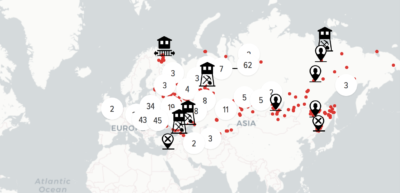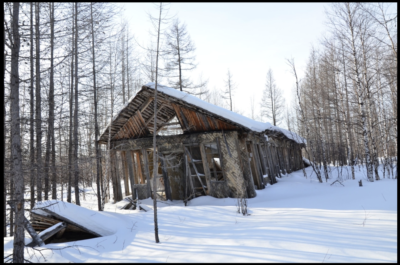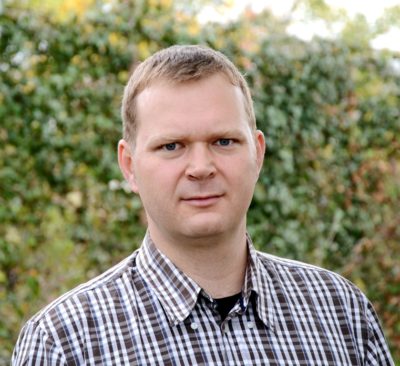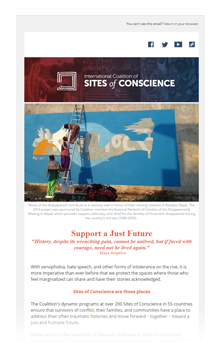Founded in 2009, Gulag.cz (Czech Republic) shares and circulates information about the Soviet gulag and its connection to the totalitarian regime in the USSR more generally. With public access to such sites increasingly difficult,  Gulag.cz maintains a virtual museum, Gulag Online (www.Gulag.cz), that provides information about specific gulags, oral histories of prisoners, archeological and archival research, and educational resources.
Gulag.cz maintains a virtual museum, Gulag Online (www.Gulag.cz), that provides information about specific gulags, oral histories of prisoners, archeological and archival research, and educational resources.
Linda Norris, Global Networks Program Director at the Coalition, recently spoke with Gulag.cz’s Chairman Štěpán Černoušek about the organization’s founding, its mission and its connection to similar projects in Europe.
How did you get started documenting gulag sites?
It’s been a process and not one moment. I started to travel to remote parts of Russia some 25 years ago and I found these places were often connected to gulags and repression. I’d see many building footprints – like factories or mines built by prisoners and then I found books and memoirs in local museums. I wanted to know about the people who lived in these remote parts — and what their relationship to the gulag was. Soviet repressions are somewhere in a deep collective subconscious in Russia; it is a very sensitive subject not expressed in public.
As time went on, Google satellite maps allowed me to discover more footprints — of an abandoned railroad built by prisoners between two cities in Northern Siberia, for instance. I could see former labor camps on the satellite photos on the map, but I couldn’t really find anything about it on the Internet. I wanted to know more.
So what did you do next?
I formed three expeditions to explore the remains of the railroad and gulag camps along it in 2009, 2011 and 2013. I also wrote several articles, but it wasn’t enough. It was then I began to organize the gulag online museum (Gulag.cz). A successful crowdfunding campaign and other support allowed us to develop it.

In 2016, we undertook another expedition to a former gulag uranium mine 500km east of Baikal Lake in southern Siberia. As a result of these expeditions and the online website, we began to be connected with others interested in the same work: Coalition members Perm-36 and Memorial, in particular.
Is this a full-time job for you?
No, I actually work full-time at the Institute for the Study of Totalitarian Regimes which focuses on Czechoslovak history. I wouldn’t call this a hobby, but I do it in my spare time.
Has the climate for doing your work changed?
A few years ago the Russian state started to have stronger control on how to interpret the Soviet past. The Russian state doesn’t want any independent interpretation of the past which would look for specific responsibility about what happened. Today’s interpretation from Russia is that repressions are not immediately connected to the Soviet state, that it was more some kind of natural disaster. Because the state is sacred, it is not possible in Russia to call the Soviet state into question.
I can feel the pressure on independent Russian organizations like Memorial. I can also see it in comments from Russia about our work.
What are your long-term goals for the project?
It would be nice to go to all the sites and to map all the remaining physical structures, but it is not realistic. There were perhaps 30,000 individual labor camps and many are completely destroyed. There is no museum built on the site of a former Stalin gulag camp in today’s Russia. We are working to learn more about new technologies such as virtual reality and augmented reality to help more people understand this story and to show them how the gulag looked like. There is so much people do not know. For instance, that the gulag contained many nationalities. Those from European countries and the United States were also repressed.

Is there a message for the future in your work?
You have to listen to the history to not repeat it, as the saying goes. But for this to happen, we have to see common moments; we have to pay attention when there is something wrong. And on the other hand, we should support positive steps. This spring I was in Kyiv, Ukraine, where the government has made a decision to talk about the past, to open all the Soviet archival files. This can open a vital space for discussion in society.
You’ve received a Fulbright and will be here in the United States for several months in 2019. Can you tell us what you’ll be doing?
My goal is to learn from American museums. I’m especially interested in how they are working with new technologies such as virtual and augmented reality. Does it really have such a big future? Another, equally important goal is to learn how American museums deal with difficult 20th-century topics. I am particularly interested in the Japanese internment camps, sites about lynchings and civil rights, and sites of incarceration like Coalition member Eastern State Penitentiary. I also want to share my experiences with colleagues in the United States and hope to discuss the mapping of remote sites like the gulags and explore possibilities for some kind of exhibition or other cooperation.


